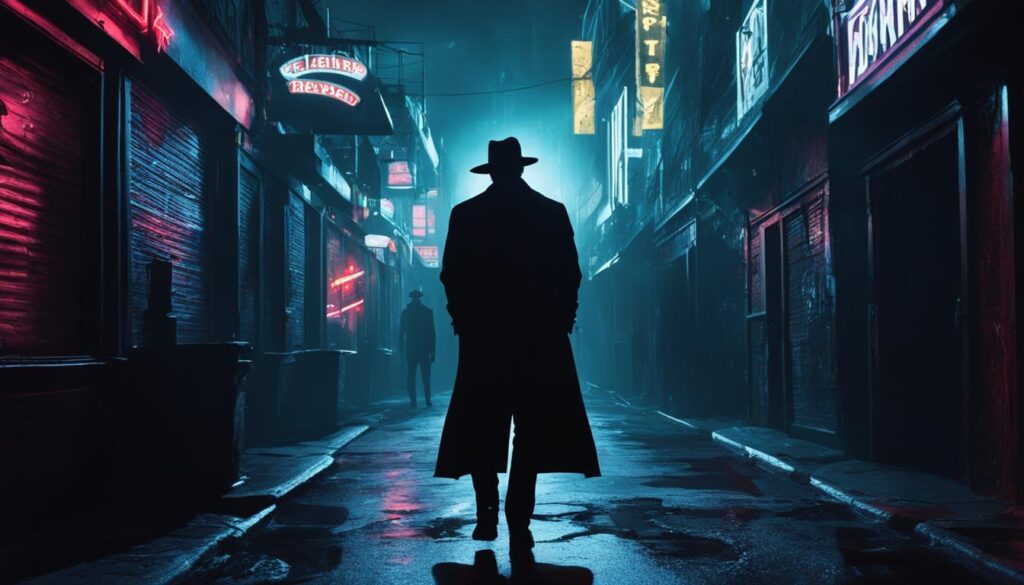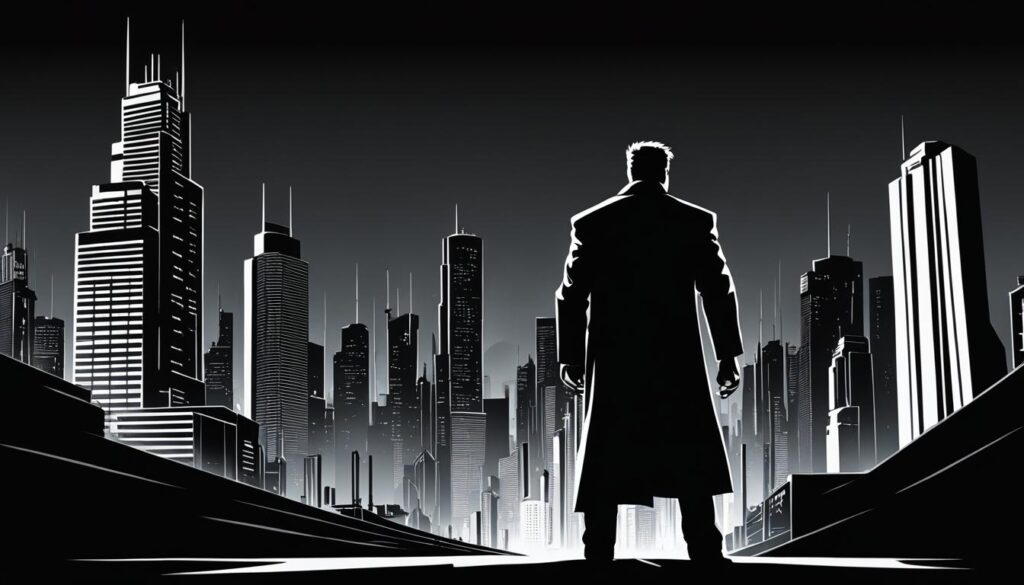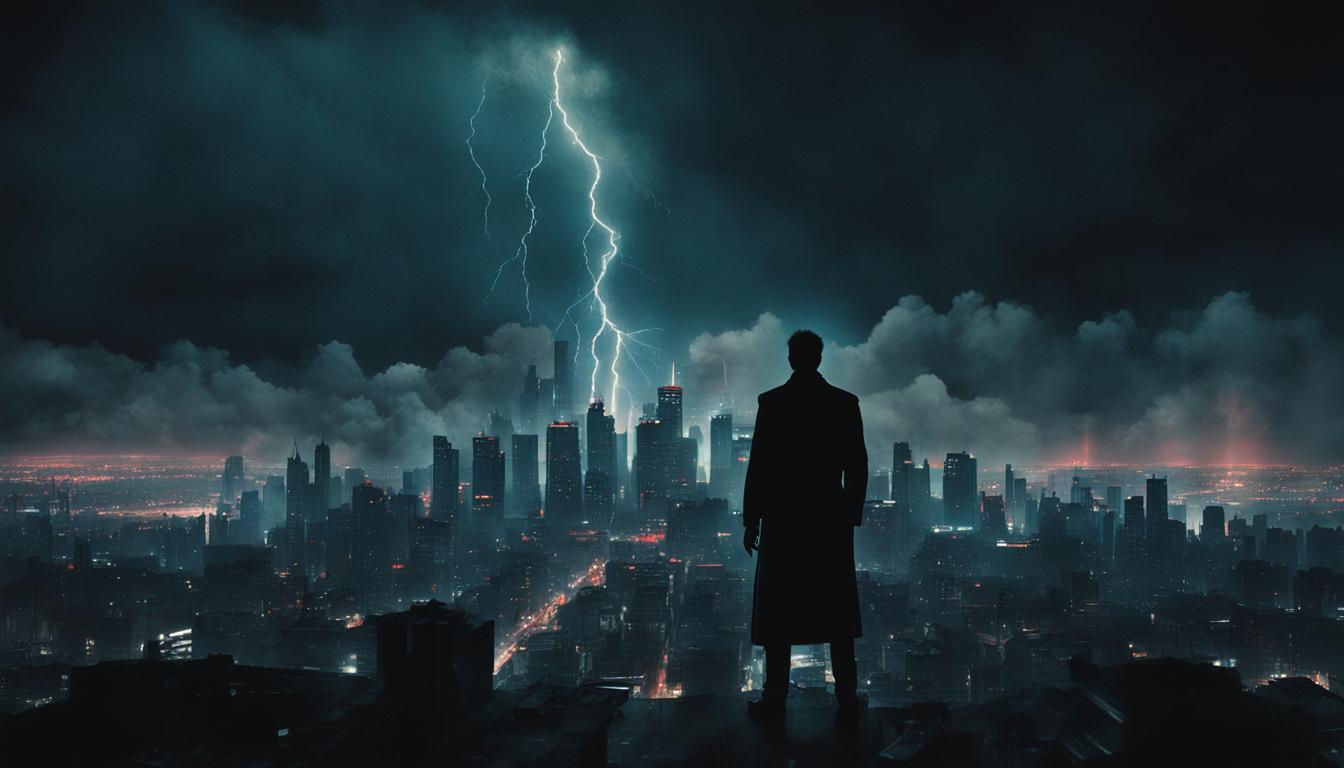Frank Miller’s “Sin City” is a graphic novel series that has captured the hearts of audiences worldwide. The dark, gritty, and noir atmosphere of the series has been translated into a successful film franchise and now into an immersive audiobook experience.
In this comprehensive audiobook review, we explore the captivating world of “Sin City” in its new audio format. We’ll dive into the storyline, characters, narration, and visual presentation of this legendary masterpiece. Join us as we evaluate whether the Sin City audiobook does justice to Frank Miller’s unforgettable creation.
Key Takeaways:
- Frank Miller’s “Sin City” is a renowned graphic novel series that has been adapted into a successful film franchise and now an audiobook format.
- The audiobook review will explore the storyline, the narration, and the visual presentation of “Sin City” in its new audio format.
- Through this audiobook review, we’ll evaluate whether the choice of audiobook enhances or detracts from the overall experience of “Sin City.”
Overview of “Sin City”
“Sin City” is a noir crime anthology graphic novel series created by Frank Miller in 1991. Miller wrote and illustrated each of the seven books in the series, which were published by Dark Horse Comics. The graphic novel series is set in a fictional city called Basin City, known for its rampant corruption, crime, and violence.
The graphic novel’s success led to the creation of a film adaptation in 2005, also titled “Sin City,” which was directed by Robert Rodriguez and Frank Miller, and starred Bruce Willis, Jessica Alba, and Mickey Rourke, among others. The film was praised for its visual style and faithfulness to the source material and spawned a sequel, “Sin City: A Dame to Kill For,” in 2014.
The Origins of “Sin City”
Frank Miller began work on “Sin City” after leaving his successful run on Marvel Comics’ “Daredevil” series. The bleak and violent stories of “Sin City” were inspired by Miller’s love of crime novels, film noir, and hard-boiled detective fiction.
The Impact of “Sin City” on the Noir Genre
“Sin City” is considered a significant work in the noir and crime fiction genres for its unique storytelling style and visual design. Miller’s use of stark black and white illustrations with carefully chosen highlights of color creates a gritty and atmospheric world that immerses readers in the corrupt and violent Basin City.
Plot Summary

Frank Miller’s “Sin City” takes readers on a dark and treacherous journey through the sin-filled streets of Basin City, where power and corruption reign supreme. The storyline is divided into seven interrelated tales, each featuring morally ambiguous characters whose lives intertwine in unexpected ways.
The book opens with “The Customer is Always Right,” which introduces the reader to the protagonist, Marv. After a one-night stand with a beautiful woman named Goldie, Marv wakes up to find her dead in his bed, murdered by an unknown assailant. Determined to avenge her death, Marv embarks on a violent quest for the killer.
“The Hard Goodbye” follows the story of another protagonist, Dwight McCarthy, who is forced to protect his former lover, Shellie, from a violent and corrupt cop named Jackie Boy. With the help of Marv, Dwight seeks revenge on Jackie Boy and the powerful men he works for.
In “The Big Fat Kill,” the tale is centered around a gang war between two groups of prostitutes and their pimps, who become embroiled in a violent conflict over the death of one of their own. Meanwhile, Dwight attempts to cover up a murder and avoid being caught by the corrupt authorities.
“That Yellow Bastard” introduces us to John Hartigan, a cop who risks everything to save an eleven-year-old girl named Nancy from a serial killer who happens to be the son of a powerful U.S. senator. When Hartigan is framed for crimes he didn’t commit, he spends years in prison, waiting for the day he can finally reunite with Nancy and protect her from the evil Yellow Bastard.
“Family Values” features the return of Dwight McCarthy, who finds himself caught up in the dangerous world of Ava Lord, a femme fatale who hires him to help her escape from an abusive husband. But when Dwight uncovers Ava’s true intentions, the situation quickly spirals out of control.
“Hell and Back” follows the story of an ex-photographer named Wallace, who gets caught up in a bizarre cult that worships a giant monster in the sewers beneath Basin City. With the help of his friend, Esther, Wallace must fight to save her from the clutches of the cult leader and uncover the truth behind the monster.
Throughout the book, readers are treated to a variety of unique and often violent storylines that come together to create a rich and immersive world. Frank Miller’s masterful storytelling and signature graphic style make “Sin City” a must-read for fans of dark, gritty noir fiction.
Audiobook Narration
In the audiobook version of “Sin City”, the performance of voice actors plays a crucial role in creating an immersive experience for listeners. Each character’s voice is distinct, bringing their personalities to life, and further driving the story. The narration of this audiobook is an outstanding and enthralling experience that captures the essence of the graphic novel.
Actor Frank Miller narrates the story, providing a captivating and authentic voice to the narrative. His deeply intoned voice adds an extra layer of immersion, highlighting the gritty world of “Sin City.” Additionally, the voice actors, who are perfectly cast, breathe life into the various characters, adding depth and complexity to the story.
The Voice Actors
The talented voice actors for “Sin City” include Josh Duhamel, Rosario Dawson, and the late Brittany Murphy, among others. Each actor convincingly portrays their character, enhancing the overall listening experience. Duhamel’s portrayal of Dwight McCarthy is pitch-perfect, capturing the anti-hero’s rough and intense personality. Dawson’s voice as Gail is fierce and commanding, while Murphy’s voice as Shellie is soft and vulnerable, providing a stark contrast to the other characters.
Immersive Experience
The audiobook format enhances the immersive experience of the “Sin City” story. Sound effects and music are used to create a mood and atmosphere that pulls listeners into the world of Basin City. Particularly effective are the occasional sound effects that mimic gunfire or explosions, which add realism to the story.
Visual Presentation

Frank Miller’s “Sin City” is renowned for its distinctive visual presentation, which combines black and white illustrations with splashes of specific colors for emphasis. This combination creates a gritty, noir atmosphere that perfectly complements the story’s dark themes. The graphic style enhances the overall narrative, immersing readers in the corrupt and violent Basin City.
Miller’s illustrations are a unique blend of realism and exaggeration, with a focus on shadow and contrast to create a sense of depth and texture. The use of stark black and white contrasts creates a striking effect that draws the reader’s eye to specific details and emphasizes the story’s darker moments.
The graphic style has had a significant impact on the comic book industry, as well as on other mediums such as film. Its influence is evident in many modern comics and graphic novels, and its iconic design has become synonymous with the “Sin City” franchise.
Table 1: Use of Color in “Sin City”
| Color | Symbolism |
|---|---|
| Red | Violence, passion, danger |
| Yellow | Fear, sickness, decay |
| Blue | Mystery, detachment, sadness |
Miller’s strategic use of color is also worth noting. Each color holds symbolism and enriches the story’s themes and tone. For example, the use of red typically denotes violence, passion, and danger, while yellow is associated with fear, sickness, and decay. Blue commonly connotes mystery, detachment, and sadness. Overall, the graphic style and Miller’s use of color contribute to the uniqueness and immersive experience of “Sin City.”
Themes and Symbolism
Frank Miller’s “Sin City” showcases a labyrinth of grim themes and profound symbolism. Corruption, vice, and violence reign supreme across the city, but Miller’s deft narrative offers a thought-provoking look into the morality of these characters.
The themes of redemption and moral ambiguity are also central to the story, with elements of justice and retribution often obscured by the murky underworld of Basin City. Miller creates a fascinating juxtaposition between the virtuous and the vile.
The Yellow Bastard and the Power of Symbolism
One of the most prominent examples of symbolism throughout the story is the character of the “Yellow Bastard.” As a symbol of corruption and pure evil, the Yellow Bastard embodies all that is wretched about Basin City, using his power and influence to commit unspeakable atrocities.
Miller’s use of color to illustrate the Yellow Bastard’s decay and corruption is a masterful instance of symbolism. As the character descends further into the depths of depravity, his appearance becomes increasingly grotesque and vile, creating a visual representation of his moral degradation.
The Themes of Justice and the Illusion of Control
The story of “Sin City” is rife with examples of the illusion of control and the tenuous nature of justice in Basin City. Despite the characters’ best efforts to navigate the corrupt landscape, violent retribution and tragedy often follow.
Miller’s exploration of power dynamics and the illusion of control emphasizes the fragility of justice in the story. The events of “Sin City” are often catalyzed by the characters’ futile attempts to take control of their situations, only leading to further chaos and ruin.
The Price of Revenge
Another recurring theme in “Sin City” is the price of revenge. Many characters are consumed by a desire for vengeance, leading them down a path of destruction and ruin. The toll of the pursuit of revenge highlights the human cost of violence and retribution, providing a sobering look at the consequences of our actions.
Reception and Impact
“Sin City” has received critical acclaim since its debut in 1991. The graphic novel has been praised for its unique visual style, compelling storytelling, and exploration of dark themes.
The series has also had a significant cultural impact, inspiring numerous works across various mediums. The film adaptation, released in 2005, garnered praise for its faithful adaptation of the graphic novel and its innovative use of digital effects.
The success of “Sin City” has cemented its place in pop culture history, becoming a recognizable and influential work in the noir genre. Its lasting legacy is a testament to Frank Miller’s creativity and the enduring appeal of the series’ themes and characters.
Overall, “Sin City” has been a groundbreaking work that has left an indelible mark on the cultural landscape. Its critical acclaim and enduring popularity stand as a testament to its artistic and literary merit.
Comparisons to the Graphic Novel and Film
In comparing the graphic novel and film adaptations of “Sin City,” it is apparent that both mediums have their unique strengths and weaknesses, contributing to the overall experience of the story. While both maintain a dark, gritty atmosphere and engage with themes of corruption and violence, there are notable examples of differences and similarities.
Similarities
- Both versions follow the intertwining storylines of morally ambiguous characters living in Basin City.
- The characters, settings, and general aesthetic are consistent between the two versions.
- Both adapt the unique and captivating visual style present in the graphic novel.
- Both the graphic novel and film maintain a faithful representation of Frank Miller’s vision.
Differences
| Graphic Novel | Film Adaptation |
|---|---|
| The structure of the graphic novel is separated into distinct volumes, whereas the film adaptation combines storylines from various volumes. | The film adaptation uses live-action actors, whereas the graphic novel is illustrated in black and white. |
| The graphic novel relies heavily on internal monologues to develop characters and themes. | The film adaptation utilizes a more straightforward narrative structure and focuses on visual storytelling. |
| The graphic novel provides a more immersive literary experience, relying on the reader’s imagination to fill in the gaps. | The film adaptation offers a more visually immersive experience with its stylized cinematography and special effects. |
Ultimately, the graphic novel and film adaptation of “Sin City” complement each other, each contributing a unique perspective to the story. The graphic novel’s narrative complexity and unique visual style translate well to the audiobook format, providing a compelling and immersive experience. Meanwhile, the live-action film adaptation offers visually stunning and engaging storytelling, bringing Frank Miller’s noir world to life on the big screen.
Conclusion
In conclusion, the audiobook version of “Sin City” is a must-listen for fans of Frank Miller’s work. The talented voice actors bring the morally ambiguous characters to life in a way that enhances the already captivating storytelling. The gritty atmosphere and unique visual style of the graphic novel are well-represented, making for an immersive experience.
Overall, our verdict is that the “Sin City” audiobook is a worthy addition to the franchise, providing a fresh way to experience the classic noir tale. Whether you’re a long-time fan or a newcomer to the series, give this audiobook a listen and see for yourself why “Sin City” remains a cultural touchstone in the world of comics and beyond.



